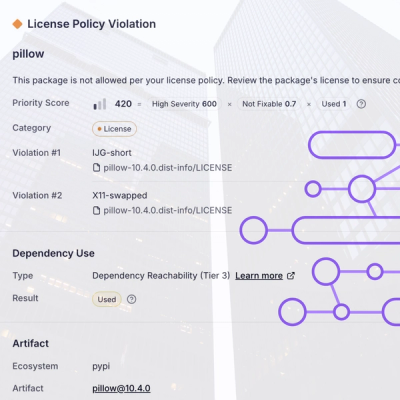
Research
/Security News
Critical Vulnerability in NestJS Devtools: Localhost RCE via Sandbox Escape
A flawed sandbox in @nestjs/devtools-integration lets attackers run code on your machine via CSRF, leading to full Remote Code Execution (RCE).
paper-range-slider
Advanced tools
A material design-style range-slider, composed of paper-slider elements
paper-range-slider allows the user to select a range of values within a given (possibly wider) range. values are selected by moving the position of two knobs, or by dragging the selected range of values within the allowed limits. paper-range-slider - v1.* is compatible with Polymer v2.* (For Polymer v1.*, use paper-range-slider - v0.2.7.)
Do either
npm i paper-range-slider
or add the following to your package.json:
"dependencies": {
"paper-range-slider": "^3.0.0"
},
<paper-range-slider></paper-range-slider>
min and max to specify the limits of values for the slider (the lower and upper bounds).value-min and value-max to set the initial position of the two knobs (the selected range of values).value-diff-min and value-diff-max to set the minimal and maximal allowed difference between the lower and upper selected values.always-show-pin to never hide the pins.snaps, pin, step, disabled.<paper-range-slider snaps pin step='1' min='0' max='100' value-diff-min="10" value-diff-max="50" value-min='30' value-max='60'></paper-range-slider>
updateValues event:<paper-range-slider id='myPaperRangeSliderId'></paper-range-slider>
<script>
document.querySelector("#myPaperRangeSliderId").addEventListener('updateValues', function (customEvent) {
console.log(' - current min/max values: ',this.valueMin,this.valueMax)
});
</script>
One can programmatically set the selected range by e.g.,
window.addEventListener('WebComponentsReady', function(e) {
var myMin = 10, myMax = 90, myEventName = 'setValues';
document.querySelector("#myPaperRangeSliderId").setValues(myMin,myMax,myEventName);
});
The third argument (myEventName) is an optional event name, which will be propagated to e.g., on-value-min-changed events.
It is allowed to set myMin and/or myMax to null or to a value outside of the allowed range, in order to ignore them, e.g., use the following to only change the lower value:
document.querySelector("#myPaperRangeSliderId").setValues(10,null);
Likewise, one can set the minimal and maximal values of the slider (the lower and upper bounds), the step-size, the minimal and maximal difference between selected values, and the disabled state. These correspond respectively to the following:
document.querySelector("#myPaperRangeSliderId").setMin(myMin);
document.querySelector("#myPaperRangeSliderId").setMax(myMax);
document.querySelector("#myPaperRangeSliderId").setStep(myStep);
document.querySelector("#myPaperRangeSliderId").setValueDiffMin(myValueDiffMin);
document.querySelector("#myPaperRangeSliderId").setValueDiffMax(myValueDiffMax);
document.querySelector("#myPaperRangeSliderId").setDisabled(isDisabled);
One can get the ratio of the current slider values in percent (within [0,1]) by e.g.,
var ratioMinMax = document.querySelector("#myPaperRangeSliderId").getRatio();
The tapValueExtend, tapValueReduce and tapValueMove properties control what happens when a user taps the slider (not e.g., relevant for when the user drags the selected range). The tapValueExtend property (true by default) allows to modify the selected range of values, by tapping on the slider below or above the selected range. On the other hand, tapValueReduce (false by default) allows to modify the selected range of values, by tapping on the slider within the selected range. Finally tapValueMove supersedes the tapValueExtend and tapValueReduce properties if set (it is false by default). If tapValueMove is enabled, tapping the slider will update the selected range, while keeping the same difference between valueMin and valueMax. One may set these properties by e.g.,
<paper-range-slider tap-value-reduce step='1' value-min='20' value-max='70' max='100' min='0'></paper-range-slider>
or programmatically with
document.querySelector("#myPaperRangeSliderId").setTapValueExtend(isTapValueExtend);
document.querySelector("#myPaperRangeSliderId").setTapValueReduce(isTapValueReduce);
document.querySelector("#myPaperRangeSliderId").setTapValueMove(isTapValueMove);
The above properties which do not have an explicit method, may be reset directly. In order for the changes to take effect properly, use the init() method. For instance, to change the alwaysShowPin option of an already-defined slider, do:
document.querySelector("#myPaperRangeSliderId").alwaysShowPin = true;
document.querySelector("#myPaperRangeSliderId").init();
It is possible to "revert" the paper-range-slider into a paper-slider (and back again) by
<paper-range-slider single-slider></paper-range-slider>
or programmatically with
document.querySelector("#myPaperRangeSliderId").setSingleSlider(isSingleSlider);
In this case, the minimal value of the range is effectively ignored. The value of the single slider may now be manipulated with e.g.,
// set a new value for the single slider
var setVal = 90;
document.querySelector("#myPaperRangeSliderId").setValues(null,setVal);
// get the current value of the single slider
var valNow = document.querySelector("#myPaperRangeSliderId").valueMax;
See also the examples in test/basic-test.html.
The following custom properties are available for styling:
| Custom property | Description | Default |
|---|---|---|
--paper-range-slider-lower-color | color for range below selected range | --paper-grey-400 |
--paper-range-slider-active-color | color of selected range | --primary-color |
--paper-range-slider-higher-color | color for range above selected range | --paper-grey-400 |
--paper-range-slider-knob-color | color of knobs | --primary-color |
--paper-range-slider-pin-color | color of pins | --primary-color |
--paper-range-slider-pin-start-color | The color of the pin at the far left | --paper-grey-400 |
--paper-range-slider-knob-start-color | The fill color of the knob at the far left | transparent |
--paper-range-slider-knob-start-border-color | The border color of the knob at the far left | --paper-grey-400 |
The license for this code is the The MIT License (MIT), as given in LICENSE.txt.
FAQs
A material design-style range-slider, composed of paper-slider elements
The npm package paper-range-slider receives a total of 2,258 weekly downloads. As such, paper-range-slider popularity was classified as popular.
We found that paper-range-slider demonstrated a not healthy version release cadence and project activity because the last version was released a year ago. It has 1 open source maintainer collaborating on the project.
Did you know?

Socket for GitHub automatically highlights issues in each pull request and monitors the health of all your open source dependencies. Discover the contents of your packages and block harmful activity before you install or update your dependencies.

Research
/Security News
A flawed sandbox in @nestjs/devtools-integration lets attackers run code on your machine via CSRF, leading to full Remote Code Execution (RCE).

Product
Customize license detection with Socket’s new license overlays: gain control, reduce noise, and handle edge cases with precision.

Product
Socket now supports Rust and Cargo, offering package search for all users and experimental SBOM generation for enterprise projects.